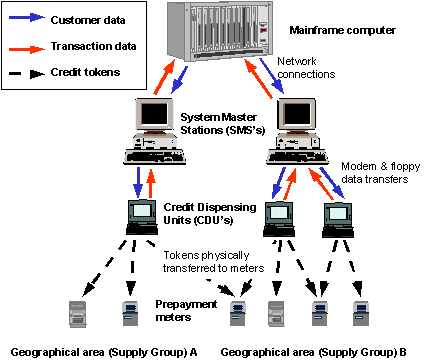Prepayment Operation
Eskom has adopted a system of prepayment metering for its domestic customers. The prepayment meters used are called EDs – short for Electricity Dispensers and ECUs – Electricity Control Units.
For offline vending, a token is purchased from a vending machine (also known as a Credit Dispensing Unit or a CDU), taken home by the customer and entered into their ED. If the token is valid the ED accepts the token and adds the credit (amount of units on the token in kWh) to the credit currently in the ED. The customer is then free to consume electricity until the credit recorded in the ED runs out, at which time the ED interrupts the electricity supply.

A token can only be entered once and is issued for use in a unique ED. i.e. The customer buys a token for their specific ED and it cannot be used in any other ED. Such a token is therefore worthless for any other consumer, removing any incentive to steal it.
Tokens can be entered at any time. The use of the ED can be paralleled with the way in which a motorist fills their motor car’s fuel tank.
Token Technologies
Eskom uses two types of token technologies for our EDs. Both types are of a use-once-and-dispose nature. The customers enter the token into their meters themselves and then dispose of the token.
The tokens types, both of which are acceptable to our customers, are:
- Disposable paper cards with a magnetic stripe (conform to ISO 7810 and 7811 size and strip location) which is entered via a slot into the ED. This is similar to a standard credit card except that it is made of paper.
- Numeric tokens – a normal paper slip on which the vending machine prints a 20 digit number. The customer then enters this number into his ED, via a keypad on the meter.
The numeric token is unique to South African EDs. Numeric tokens have the advantage that they do not have to be physically transported, making them ideal for sale over the telephone
Prepayment is a Systems Approach
For normal conventional meters, the functions of Technical Support, Maintenance, Revenue Collection and Management can to a large extent be operated autonomously. It is however important to recognise that, prepayment is not simply about the meter itself and requires an integrated systems approach.
The need for effective and available sales points as well as proper sales management systems (made up of both manual person based as well as computer equipment based components) should not be underestimated. Getting bills out 2 days late does not deprive customers of electricity, whereas prepayment sales points that inoperative for 2 days, will cause some significant customer inconvenience!
Prepayment General Information
At the bottom of the Specification page is a section on Generic Technical Information that contains some overview documentation about STS.
